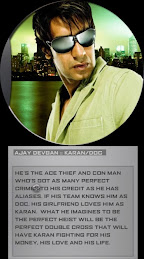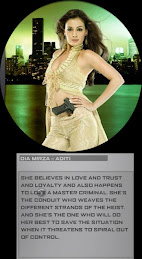Bollywood is part of the Indian Cinema, it creates the main phase of the indian film industry. Although Bollywood's birth was in 1913, indian films started to get its real shape in the late 1960's and 70s. We started to see male protagonists who started to get real roles, which made them active than ever before. Male significance was soaring high while the female was hardly shown in the film, this would be the mother or the wife. Male roles included such as romantic guy, the action man, and playing roles in gritty and violent movies. The asian culture is a true reflection of Bollywood, typically the man worked hard and brought money in to the household whereas the women brought up children and played as a good housewife.
Bollywood had shown the typical patriarchy in the 2oth century of its cinema.
Ms. Jones im really stuck, i do not know how to get around this. Please Help
Thursday, 10 January 2008
Sunday, 6 January 2008
...Essay Plan...
Hypothesis:
To show that typical Patriarchy in Bollywood films are subverting and that the significance of Women has started to increase, as we are changing the way we live in society, i.e not living in a Patriacrhal soceity.
Intro:
Talking about patriarchy in Bollywood. In general
· Men were seen as dominant
· Roles on man
· roles of women
· the stereotypes
Have a paragraph on- Historical texts
Mughal-e-Azam (1960), the whole narrative was about an Emperor’s son who falls in love with a courtesan. The film reinforces the dominance of one man over India and show women being entertainers/dancers for the rich.I would look at the roles of female protagonists along with the male protagonists. Concluding the role of the women in the film.
Chaal Baaz (1989), has a split representation of women, we see actor Sridevi playing a double role. Separated at birth are two twins, one who plays a bird-in-cage role and a modern club dancer. Even though the modern club dancer has a modern profession and sees men are equal to women, she still needs support of men. I would look at the roles of the female protagonists with the male protagonists. Comparing the two opposite roles and concluding how the film represents women. Look closely at Chaal Baaz, analyse the characteristics of Sridevi. Red lipstick connotes seduction, trying to achieve the ‘male gaze’. This states that women are there for fantasy/ selling herself.
Mother India (1957) - Seen to carry out man’s roles. A struggling mother. Look at her role, as this changed Bollywood totally. It did shake Bollywood as it was a moving film. The film created a Masochistic view for the audience. In Freud’s ‘Three Essays on the Theory of Sexuality’ (1905d) he remarked ‘Masochism is associated with passivity and sadism with activity. An essential characteristic of the perversions is that the active and passive forms are found in the same individual.’ So in this case Radha a lead female actor had masochistic characteristics, which built over the course of the movie.
Maine Pyar Kiya (1989) - The movie song enforces the idea of women being the typical ‘housewife’ and the guy outside fixing his car.Have a paragraph on-
Talk about Laura Mulvey theory: The ‘male gaze’ I will refer back to the historical films.
Have a Paragraph on- Cash (2007)
- What is shown, the representation of women.
- The themes
Have a paragraph on-
Talking about ACTIVE vs. PASSIVE. So Cash (2007) has shown all women being active, whereas all other historical movies reinforced the passive side
Have a paragraph on- Identity change.
Older films- Sex symbols, objects of sex and passive roles.
New films, Cash (2007) - Sex symbols/references to sex-sexual innuendo and Active roles.
Have a Paragraph on- The ‘new man’
Look at films-
-Cash, man listens to his wife, follows instructions.
- Dhoom2- man cooks for wife. He takes care of the kitchen.
Have a Paragraph on- Compare Hollywood to Bollywood.
-Is Bollywood imitating Hollywood
- Look at films such as Kill Bill, and Tomb raider compare with new Bollywood movies.
-Kill bill- Tight clothes-yellow-attractive.
Conclusion-
Although Cash girls are still being objectified, which hasn’t changed since the birth of Bollywood. They have started to get resourceful roles but still shown women being the subject of the ‘male gaze.’
To show that typical Patriarchy in Bollywood films are subverting and that the significance of Women has started to increase, as we are changing the way we live in society, i.e not living in a Patriacrhal soceity.
Intro:
Talking about patriarchy in Bollywood. In general
· Men were seen as dominant
· Roles on man
· roles of women
· the stereotypes
Have a paragraph on- Historical texts
Mughal-e-Azam (1960), the whole narrative was about an Emperor’s son who falls in love with a courtesan. The film reinforces the dominance of one man over India and show women being entertainers/dancers for the rich.I would look at the roles of female protagonists along with the male protagonists. Concluding the role of the women in the film.
Chaal Baaz (1989), has a split representation of women, we see actor Sridevi playing a double role. Separated at birth are two twins, one who plays a bird-in-cage role and a modern club dancer. Even though the modern club dancer has a modern profession and sees men are equal to women, she still needs support of men. I would look at the roles of the female protagonists with the male protagonists. Comparing the two opposite roles and concluding how the film represents women. Look closely at Chaal Baaz, analyse the characteristics of Sridevi. Red lipstick connotes seduction, trying to achieve the ‘male gaze’. This states that women are there for fantasy/ selling herself.
Mother India (1957) - Seen to carry out man’s roles. A struggling mother. Look at her role, as this changed Bollywood totally. It did shake Bollywood as it was a moving film. The film created a Masochistic view for the audience. In Freud’s ‘Three Essays on the Theory of Sexuality’ (1905d) he remarked ‘Masochism is associated with passivity and sadism with activity. An essential characteristic of the perversions is that the active and passive forms are found in the same individual.’ So in this case Radha a lead female actor had masochistic characteristics, which built over the course of the movie.
Maine Pyar Kiya (1989) - The movie song enforces the idea of women being the typical ‘housewife’ and the guy outside fixing his car.Have a paragraph on-
Talk about Laura Mulvey theory: The ‘male gaze’ I will refer back to the historical films.
Have a Paragraph on- Cash (2007)
- What is shown, the representation of women.
- The themes
Have a paragraph on-
Talking about ACTIVE vs. PASSIVE. So Cash (2007) has shown all women being active, whereas all other historical movies reinforced the passive side
Have a paragraph on- Identity change.
Older films- Sex symbols, objects of sex and passive roles.
New films, Cash (2007) - Sex symbols/references to sex-sexual innuendo and Active roles.
Have a Paragraph on- The ‘new man’
Look at films-
-Cash, man listens to his wife, follows instructions.
- Dhoom2- man cooks for wife. He takes care of the kitchen.
Have a Paragraph on- Compare Hollywood to Bollywood.
-Is Bollywood imitating Hollywood
- Look at films such as Kill Bill, and Tomb raider compare with new Bollywood movies.
-Kill bill- Tight clothes-yellow-attractive.
Conclusion-
Although Cash girls are still being objectified, which hasn’t changed since the birth of Bollywood. They have started to get resourceful roles but still shown women being the subject of the ‘male gaze.’
Friday, 4 January 2008
...Historical Texts...
Mughal-E-Azam (1960)
Plot Oultine
Set in the 16th century AD, the movie brings to life the tale of the doomed love affair betw een the Mughal Crown Prince Saleem and the beautiful, ill-fated court dancer, whose fervor and intensity perpetrates a war between the prince and his father the great Mughal Emperor Akbar, and threatens to bring an empire to its knees.
een the Mughal Crown Prince Saleem and the beautiful, ill-fated court dancer, whose fervor and intensity perpetrates a war between the prince and his father the great Mughal Emperor Akbar, and threatens to bring an empire to its knees.
Badshah Akbar was the supreme ruler of Hindustan and ruled this country fairly and justly. He wanted the Hindus and Muslims to live as a big family; encourages all religious groups to live in harmony together; and even undertakes a barefoot journey to the temple of Ambe Maa and installs a gold umbrella over Ambe Maa. He married a Hindu Rajput Yodhabai, and together they sire a son who they name Saleem. Born in a very tolerant and acceptable atmosphere, Saleem also witnesses war and perhaps this does have an affect on his mind. He then falls in love with a lowly courtesan, Anarkali. When his parents want him to get married to a woman of their choice, he refuses and wants to marry Anarkali. This angers the tolerant Akbar, who could never visualize his son marrying a mere dancing girl. He has Anarkali imprisoned, but Saleem arranges her escape and incites a open revolt against Akbar. Enraged, Akbar declares Saleem a traitor and sends his armies to crush him. Saleem is defeated and brought in chains to be sentenced by his father, but Anarkali managed to elude his armies. Akbar wants to trade Saleem's life with that of Anarkali, but Saleem will not let anyone know where Anarkali is, and is therefore sentenced to die. Watch the climax, to the tunes of "Zindabad...Zindabad...." of this blockbuster as Saleem is tied to a tower and a huge cannon is aimed at him to blow him to bits in front of everyone present.
 een the Mughal Crown Prince Saleem and the beautiful, ill-fated court dancer, whose fervor and intensity perpetrates a war between the prince and his father the great Mughal Emperor Akbar, and threatens to bring an empire to its knees.
een the Mughal Crown Prince Saleem and the beautiful, ill-fated court dancer, whose fervor and intensity perpetrates a war between the prince and his father the great Mughal Emperor Akbar, and threatens to bring an empire to its knees.Badshah Akbar was the supreme ruler of Hindustan and ruled this country fairly and justly. He wanted the Hindus and Muslims to live as a big family; encourages all religious groups to live in harmony together; and even undertakes a barefoot journey to the temple of Ambe Maa and installs a gold umbrella over Ambe Maa. He married a Hindu Rajput Yodhabai, and together they sire a son who they name Saleem. Born in a very tolerant and acceptable atmosphere, Saleem also witnesses war and perhaps this does have an affect on his mind. He then falls in love with a lowly courtesan, Anarkali. When his parents want him to get married to a woman of their choice, he refuses and wants to marry Anarkali. This angers the tolerant Akbar, who could never visualize his son marrying a mere dancing girl. He has Anarkali imprisoned, but Saleem arranges her escape and incites a open revolt against Akbar. Enraged, Akbar declares Saleem a traitor and sends his armies to crush him. Saleem is defeated and brought in chains to be sentenced by his father, but Anarkali managed to elude his armies. Akbar wants to trade Saleem's life with that of Anarkali, but Saleem will not let anyone know where Anarkali is, and is therefore sentenced to die. Watch the climax, to the tunes of "Zindabad...Zindabad...." of this blockbuster as Saleem is tied to a tower and a huge cannon is aimed at him to blow him to bits in front of everyone present.
Notes
- Women for the rich were just dancers and performers, that kept the Rich entertained.
Similarites and Differences to my Hypothesis (for CASH 2007)
- Character Roles- Women in Cash have a active role, being strong, bold. Whereas women in Mughal-E-Azam are shown passive, being more feminin, fragile and naive.
- Props- Women in Cash are scantily clad whereas in Mughal-E-Azam women are fully covered (they followed the norms and values of the asian tradition...to be fully covered.)
- Action packed in Cash whereas in Mughal-E-Azam they just show life surrounding around the rich and the Dancing Brothel
- Cash female characters shown working in professional field whereas Mughal-E-Azam female characters are just for entertainment.
- Cash female characters shown working in professional field whereas Mughal-E-Azam female characters are just for entertainment.
- Patriarchy (men ruled) in Mughal-E-Azam, women followed man's instructions.
- Cash protagonists were out going, socialable, free as a bird whereas women protagonists in Mughal-E-Azam were closed in walls, seemed trapped.
- No similarities
ChaalBaaz (1989)
Anju and Manju are twins separated when babies thanks to their mentally retarded nanny. An evil uncle Tribhuvan gets their parents killed in a car accident. He brings up Anju as coy (people who avoid social situations) and easily frightened girl. Manju grows up in a bastee as a happy-go-lucky club dancer. After a lot of terrifing days in Anju's life, one day she runs away from home. On that very day, Manju has a fight with her childhood companion and neighbor Jaggu, a friendly beer drinking taxi driver. With twist of fate, their paths cross but they never meet. They somehow end up at each others place. Sooraj is the love interest in Anju's life who is actually Manju and Jaggu is...It is better to watch the entire movie. There is the usual confusion of identities.
Anju (Sridevi) lives with her Uncle, Tribhuvan (Anupam Kher) and aunt, Amba (Rohini Hattangadi), who abuse her both physically and emotionally all the time, and also keep her drugged, so she is dependant on them all the time. They live in a big mansion, and therefore, Anju is forced to do all the housework. Anju's passion is dancing and her Uncle prevents her from perusing this. Dayal (Annu Kapoor) does his best to protect Anju from the frequent beatings.(Annu needs mans protection) Meet Anju's look-a-like (also played by Sridevi), who lives in small tenement, drinks beer, fights with men, dances, lies, amongst other things. Manju's mom (Aruna Irani) has psycological problems and is hospitalized, and Manju's friend is Jaggu (Rajnikanth), who is quiet and soft-spoken, and will only get into a fight to protect Manju. Tribhuvan's friend's name is Vishwananth (Saeed Jaffrey), who wants his son, Suraj (Sunny Deol) to marry Anju. Suraj is a lot like Manju, and he has even met Manju in the beer bar, and thinks the photograph of Anju is Manju. And on the other hand Tribhuvan and Amba want Anju to marry Batuknath Lalanprasad Malpani (Shakti Kapoor), who is the nephew of Amba. One day Anju and Manju are taken for each other and what results is absolute chaos, as each try to fit into the other's shoes.
Similarites and Differences to my Hypothesis (for CASH 2007)
- 1 of the characters have an active role
- Shown independancy in Manju-living out.
- One twin shown unsocialble and one very sociable.
- One twin shown unsocialble and one very sociable.
-Differences such as Women being clingy, need support of man when in trouble.
-Differences- Heavily dependant on man
-Differences- Heavily dependant on man
-Difference- Men seem to control women, i.e. the husband, the lover, the friend.
!!!Sir it is really hard to find Historical Texts!!!
My personal thought is that Bollywood is still today tied back with strings to its Norms and Values, to its culture, its tradition and it cannot move forward as the industry hopes. Someone who break these Norms and Values do not succeed in the Industry and are pointed at- e.g. Dhoom2 kissing scene.
It seems as Bolly is stuck between/glued back.
It seems as Bolly is stuck between/glued back.
Looking at Bollywood pre-1990 compared to post-1990, there does seem a change in the significance of women, they get active roles or seem to be more resourceful than ever before.
Thursday, 3 January 2008
Task 11...Laura Mulvey
a) A Political Use of Psychoanalysis
Film reflects the langauge of partriarchy by being bound up in the same story of sexual difference that all patriarchy is founded on. In film women is seen as Other, as an object not a subject. In a way she represents the unconscious of the male because she is always the object he is looking at and never is able to speak for herself.
Phallocentrism -- a world view which sees the penis (symbolic and otherwise) as the defining center of meaning. In other words-- there is a central, stable meaning to things; that meaning is defined largely by men who associate their power to name and define and control reality with their masculinity.
Symbolic Order -- the realm of meaning controlled by the Law of the Father (in Lacan's theorizing): the language of partriachy. As opposped (by Kristeva) to the Imaginary -- the primal language of connectiona sscoiated with pre-Oedipal bonding with the mother.
b) Destruction of Pleasure as a Radical Weapon
Hollywood film reflects the dominant ideology of their culture. We get our pleasure from films from this presentation of the erotic. If we learn to make films which do not encode these ideologies, a lot of people will lose their pleasure in looking at film.
Mise-en-scene means staging an action. It is historically to do with directing plays, and became later to do with film to express how the material in the frame is directed.
http://virtual.clemson.edu/groups/womenstudies/flc436/mulvey.html
Film reflects the langauge of partriarchy by being bound up in the same story of sexual difference that all patriarchy is founded on. In film women is seen as Other, as an object not a subject. In a way she represents the unconscious of the male because she is always the object he is looking at and never is able to speak for herself.
Phallocentrism -- a world view which sees the penis (symbolic and otherwise) as the defining center of meaning. In other words-- there is a central, stable meaning to things; that meaning is defined largely by men who associate their power to name and define and control reality with their masculinity.
Symbolic Order -- the realm of meaning controlled by the Law of the Father (in Lacan's theorizing): the language of partriachy. As opposped (by Kristeva) to the Imaginary -- the primal language of connectiona sscoiated with pre-Oedipal bonding with the mother.
b) Destruction of Pleasure as a Radical Weapon
Hollywood film reflects the dominant ideology of their culture. We get our pleasure from films from this presentation of the erotic. If we learn to make films which do not encode these ideologies, a lot of people will lose their pleasure in looking at film.
Mise-en-scene means staging an action. It is historically to do with directing plays, and became later to do with film to express how the material in the frame is directed.
http://virtual.clemson.edu/groups/womenstudies/flc436/mulvey.html
Subscribe to:
Posts (Atom)








